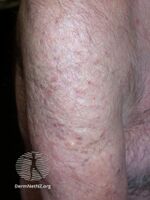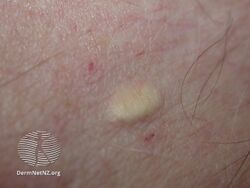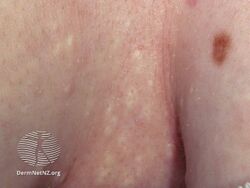Steatocystoma multiplex
| Steatocystoma multiplex | |
|---|---|
| Other names: Epidermal polycystic disease, sebocystomatosis[1]: 781 | |
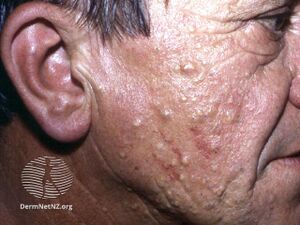 | |
| Steatocystoma multiplex | |
| Specialty | Dermatology |
Steatocystoma multiplex is a benign, autosomal dominant congenital condition resulting in multiple cysts on a person's body. Steatocystoma simplex is the solitary counterpart to steatocystoma multiplex.[2]
In steatocystoma multiplex, the tendency to develop cysts is inherited in an autosomal dominant fashion, so one parent can be expected to also have steatocystoma multiplex. It may also occur sporadically. Both males and females may be affected.
The onset at puberty is presumably due to hormonal stimulus of the pilosebaceous unit. They most often arise on the chest and may also occur on the abdomen, upper arms, armpits and face. In some cases cysts may develop all over the body.
The cysts are mostly small (2-20 mm) but they may be several centimetres in diameter. They tend to be soft to firm semi-translucent bumps, and contain an oily, yellow liquid. Sometimes a small central punctum can be identified and they may contain one or more hairs (eruptive vellus hair cysts). They may become inflamed and heal with scarring, like acne nodules (see nodulocystic acne and hidradenitis suppurativa).
Steatocystomas are thought to come from an abnormal lining of the passageway to the oil glands (sebaceous duct).
Localised, generalised, facial, acral, and suppurative types of steatocystoma multiplex have been described.
Signs and symptoms
The presentation of this condition is consistent with kidney stones and multiple cysts on the skin for those affected[3]
-
Steatocystoma multiplex
-
Steatocystoma multiplex
-
Steatocystoma multiplex
Causes

It is associated with defects in Keratin 17.[4] The condition is inherited in an autosomal dominant manner. This indicates that the defective gene responsible for a disorder is located on an autosome, and only one copy of the defective gene is sufficient to cause the disorder, when inherited from a parent who has the disorder.
However, a solitary case can also emerge in a family with no prior history of the disorder due to the occurrence of a mutation (often referred to as a sporadic or spontaneous mutation).[citation needed]
Diagnosis
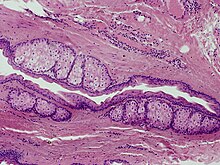
It is difficult to diagnose genetic and rare diseases. Healthcare professionals would look at a combination of a patient's medical history, symptoms, physical exam and other laboratory tests to inform their diagnosis.[5]
Treatment
The cysts can be removed via excision, though conventional cyst excision techniques have proven impractical, and a specialized regimen is required.[6]
Cryotherapy and electrosessication may also be tried, but since it is genetic disorder so all the modalties have very little effect.
Individual cysts can be removed surgically. In most cases, small incisions (cuts into the skin) allow the cyst and its contents to be extracted through the opening. If it is tethered to the underlying skin, excision biopsy may be necessary. Cysts can also be removed by laser, electrosurgery or cryotherapy. Inflammation can be reduced with oral antibiotics. Oral isotretinoin is not curative but may temporarily shrink the cysts and reduce inflammation.[7]
See also
- Keratin disease
- Steatocystoma simplex
- List of cutaneous conditions
- List of cutaneous conditions caused by mutations in keratins
References
- ↑ Freedberg, et al. (2003). Fitzpatrick's Dermatology in General Medicine. (6th ed.). McGraw-Hill. ISBN 0-07-138076-0.
- ↑ Davey, Mathew. "Steatocystoma Multiplex". Archived from the original on 12 April 2019. Retrieved 25 May 2011.
- ↑ "Steatocystoma multiplex | Genetic and Rare Diseases Information Center (GARD) – an NCATS Program". rarediseases.info.nih.gov. Archived from the original on 15 April 2021. Retrieved 2 June 2021.
- ↑ Smith FJ, Corden LD, Rugg EL, et al. (1997). "Missense mutations in keratin 17 cause either pachyonychia congenita type 2 or a phenotype resembling steatocystoma multiplex". J. Invest. Dermatol. 108 (2): 220–3. doi:10.1111/1523-1747.ep12335315. PMID 9008238.
- ↑ "Steatocystoma multiplex | Genetic and Rare Diseases Information Center (GARD) – an NCATS Program". rarediseases.info.nih.gov. Archived from the original on 2021-04-15. Retrieved 2021-01-02.
- ↑ Pamoukian VN, Westreich M (1997). "Five generations with steatocystoma multiplex congenita: a treatment regimen". Plast. Reconstr. Surg. 99 (4): 1142–6. doi:10.1097/00006534-199704000-00036. PMID 9091916.
- ↑ "Steatocystoma multiplex | DermNet NZ". dermnetnz.org. Archived from the original on 2020-07-10. Retrieved 2020-07-10.
External links
| Classification | |
|---|---|
| External resources |
